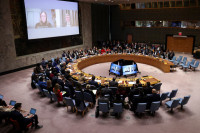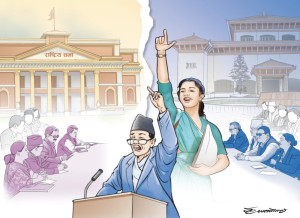Columns
New eyes and ears
There is much to do before Nepali society appreciates the likes of Sapana Roka Magar without the instructive gaze of the international media.
Pramod Mishra
Why hadn’t I heard of Sapana Roka Magar and her work before? This past week she is everywhere; there is hardly a media outlet that doesn’t have a report about or an interview of her. Once the BBC chose her as one of the 100 most influential women in the world for 2020, she suddenly became a darling of the Nepali media. Every news outlet has scrambled to have a piece of her—for the right reasons. Yet, again, why hadn’t the regular consumers of news in Nepal known about her story? And why hadn’t we heard of the man, Binaya Jung Basnet, whom she calls father, who heads an organisation that takes care of unclaimed bodies and performs their last rites at Kathmandu’s cremation ground on the Bagmati river.
Both the 18-year-old woman and her father figure should have been newsworthy, because of who they were and what they did—without getting into the details of Sapana’s roller-coaster teenage life. For one thing, it was not only unusual but unheard of for a female to personally take part in corpse management and perform cremation rites.
In the past few years, there have been news media reports of daughters shouldering their father’s or mother’s bodies to the cremation ground and lighting the ritual fire when there is no son to do so. And these daughters have also led the 13-day mourning ritual in white. These rare examples have been considered newsworthy because, until recently, in the absence of a male child, the nearest male relative has performed the final rites and mourning rituals in the Hindu tradition. A female relative, even if she is a daughter of the deceased, is traditionally not permitted this duty because, supposedly, it doesn’t help the soul of the deceased to obtain salvation.
But in this case, it was a teenager in jeans and shirt accompanied by a Chhetri man—second from the top in the caste hierarchy—claiming the unclaimed bodies from the streets and hospital morgues and hauling them to the cremation ground and burning them after performing the basic religious rites.
The failure of the national media in noticing this unheard-of social work before a member of the Western media chose to highlight the teenager’s work by selecting her alongside the likes of Hollywood star and activist Jane Fonda, the prime minister of Finland and other luminaries raises a number of questions about value formation in South Asia. How does society create value? What does it consider noteworthy or notable achievement?
The act of collecting and cremating unclaimed bodies itself is considered the work of the lowest rung in Hindu society. Cremation is a duty performed by either one’s kinsmen or by what is called in the Shastras as chandal (now Mahadalits), as highlighted in the Hindu scriptural story of King Harishchandra reduced to the status of a chandal at the burning ghats of Benaras. In the case of the kinsmen, they get purified only on the 13th day, having gone through austere rituals of purification that includes foregoing even salt, let alone non-vegetarian food, and consuming five purportedly purifying things, including cow dung and cow urine.
The Mahadalit that traditionally burns dead bodies even now at the ghats of Varanasi can never purify themselves in the eyes of the Hindu dharmashastras because they are born that way. The media at home only pay attention to tough and socially unacceptable work when people like Mother Teresa or Roka Magar, promoted by the international media or donors, are recognised. Otherwise, society and the media (born of the same society) turn a blind eye, because the caste-based society doesn’t approve of lowly, polluting work—which is what cremation is considered to be. And this ideology is still ingrained and entrenched in every Hindu village and town even today.
Hindu society believes in building temples for worshippers and dharamshalas for pilgrims, not schools for the indigent and the downtrodden. There is no philosophy that warrants service to the needy unless the indigent is an ascetic. Hindus believe in donating to priests, not to the education and advancement of the disadvantaged. It is not to say that temples and priests shouldn’t receive donations from fellow devotees, but to emphasise that even the charity-run schools are meant only for producing Brahmin priests rather than educating pupils from all walks of society who can’t do so on their own is taking it too far.
Human life doesn’t hold much meaning for a traditional Hindu outside of the ideology of caste and gender prescription. You can even now find those learned in Sanskrit, produced by India’s and Nepal’s premier Sanskrit colleges and universities, spouting the diktats of Manusmriti on social media. And if that’s the case of the learned Hindu versed in the scriptures, what can you say about the father in Rautahat district who hired killers to murder his teenage daughter a few months ago (who has subsequently been arrested)? He feared that by divorcing her ritually married husband and falling in love with a man of another caste, his daughter was destroying her own and her family and caste’s honour.
What all this means is that the society as it exists right now has a skewed value system. And this value system has been maintained by the ideology that emanates from the religious texts, enforced unquestioningly by the priests and imposed by the caste and kinship network among the Hindus. The media has come a long way in the past decade and a half since the country became a republic, but it has to go a long way to forsake the old lens and wear a new set that is rooted in human values rather than caste values. There is much to do before South Asian society takes in a worldview that is deep in spirituality, rather than in the clerical rituals of the priests. Only then will it be able to see the deeply humanistic works of a Sapana Magar and a Binaya Basnet without the instructive, branding gaze of the international media. Until then, let’s cultivate such eyes and ears to see and value life and society in a novel way to restore humanity over caste cosmology.




 15.69°C Kathmandu
15.69°C Kathmandu















